Learn Basic Drawing
Drawing Lesson One: Using The Right Drawing Materials
Using the right drawing materials is important. Your skills and learning will be handicapped by using materials that are meant for other purposes.
Drawing tablet Purchase a 9" x 12" spiral bound sketch book of at least 50 sheets of acid-free, medium weight, fine grain paper. Perforated pages are preferable.
Drawing pencils Drawing pencils come in a variety of several hardnesses. Softer leads produce a wider variety of tones--black to light gray. I recommend HB graphite for detail work and fine lines and 2B or 6B for shading.
Sharpeners Manual or electric sharpener.
Erasers Kneaded erasers can be molded to erase very small areas. A regular pencil eraser has an abrasive content of fine grit and will scuff your drawing paper and make it difficult to produce good shading and drawing results.
All of these drawing materials can be purchased on line or at your favorite art supply store.
The technique of shading in drawing is vital to the creation of volume, light and shadow. I teach students to use a multi-directional cross-hatched pencil stroke that develops values from dark blacks, to grays to very light grays that lead to white (bright illumination.)
Lesson Two: Shading-- A Circle Becomes A Sphere
Here is my video that demonstrates this technique.
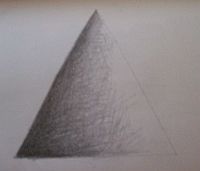
Try shading other shapes like squares, rectangles and triangles. First determine a source of light. For example, if you decide the light is coming from the right then the right side of the shape will be very light. On the opposite side there is shadow so you will need to create very dark to black gradations to create shadow.
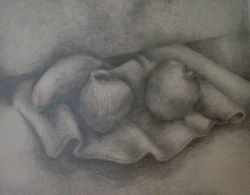
Still Life in natural lighting
Set up an arrangement--I suggest simple shapes like apples and oranges and a mug or teapot For a little more challenge, set the objects of a piece of fabric or a towel. There will be many different shadows and light areas because in a normal setting they will be in multi-directional light. Use the shading skills you learned in the first exercises. Make dark shadows on the left and light areas on the right of each object. Keep it simple! Don't worry! We are all hard-wired to read light and dark areas as light and shadow. Then just shade. This works!
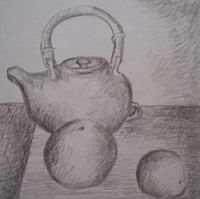
Still Life in controlled lighting
Darken a room or area, set up a light on either the right or left of the apple and oranges. Observe the shadow and lighting closely and try as accurately as possible to shade the objects.
Practice shading using imagined light, natural light and controlled light on simple shapes and objects. This skill, once you master it, translates to other materials: charcoal, conte crayon, colored pencil and pen and ink as well as painting.
Real Feedback
You said everybody can draw, even if they can't draw a straight line. So I am working on how you told me to do the still life and really am having fun! Just want you to know I'm drawing and shading and love it!
Millie
----
Our Girl Scout Troop did the landscape drawing lesson at Camp, then we had a show of their work. Even the counselors were impressed!
Thanks, Lois!
Mrs. Ritter and daughter Jennifer
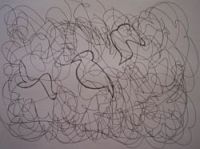
Frequently bird and fish forms are found as recognizable images in doodles. The student that did this doodle remarked that she could never have thought to draw those graceful shapes. Later, she used similar shapes in a painting.
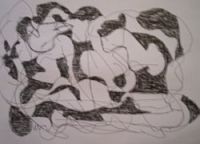
The student developed this pen and ink doodle drawing into a musical movement of swirling shapes of black and white.
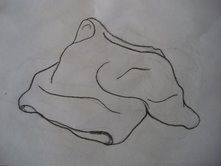
Above is a student pen and ink drawing of drapery. Seeing drapery as geometrical shapes like cylinders or simple shapes like hills and valleys will help you visualize how to draw the folds correctly. Look carefully at the forms, sketch them first as the simple forms you see (cylinders, hills and valleys.)
Then look again and see how the drapery differs from the simple forms.
With this technique, so much of the line has to express the actual form! With a little practice, your line can articulate any volume, form or shape. An exquisite line is like a haiku or a beautiful little poem.
This method of simplifying what you see works well for anything that entices your eye and makes you want to draw it, whether it be your cat, an old log on a seashore, a house or a self portrait.